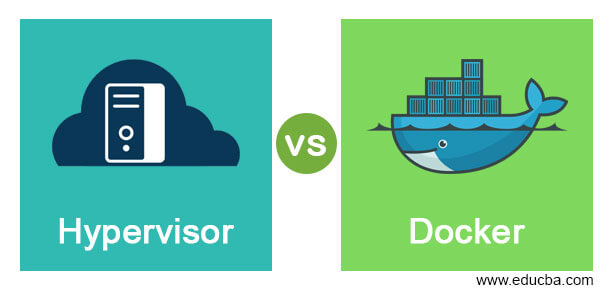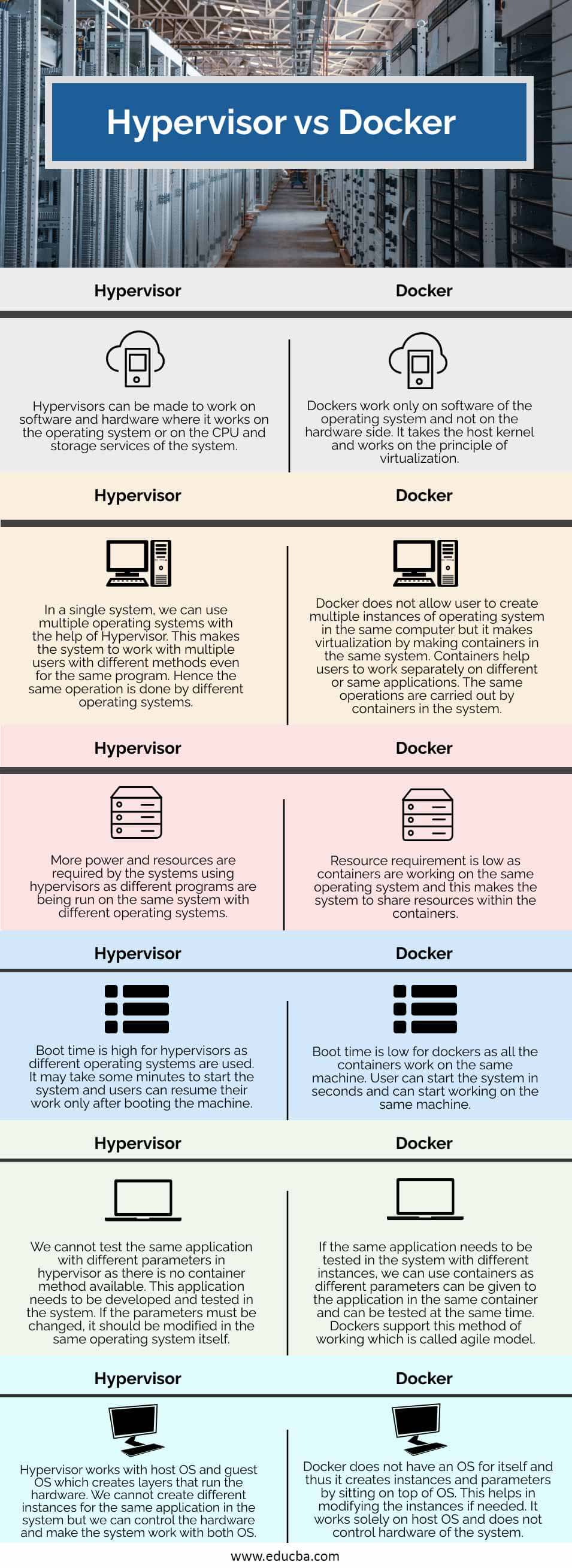Updated March 6, 2023

Introduction to Hypervisor vs Docker
The software that helps in the creation of Virtual machines where a virtual platform is provided to the operating systems to manage and execute the virtual machines is called Hypervisor which is otherwise called Virtual Machine Monitor or Emulator or Virtualizer. One system can control various virtual machines and this helps to manage the working of virtual machines via hypervisor.
Docker is a service for virtualization used in OS where software is delivered in containers with software, libraries, and configuration files. Written in Go language and developed by Solomon Hykes, the applications are created and deployed using containers and are developed as packages inside the same.
Head to Head Comparison Between Hypervisor vs Docker (Infographics)
Below are the top 6 differences between Hypervisor vs Docker:
| Hypervisor | Docker |
| Hypervisors can be made to work on software and hardware where it works on the operating system or on the CPU and storage services of the system. | Dockers work only on the software of the operating system and not on the hardware side. It takes the host kernel and works on the principle of virtualization. |
| In a single system, we can use multiple operating systems with the help of Hypervisor. This makes the system to work with multiple users with different methods even for the same program. Hence the same operation is done by different operating systems.
|
Docker does not allow users to create multiple instances of operating systems in the same computer but it makes virtualization by making containers in the same system. Containers help users to work separately on different or the same applications. The same operations are carried out by containers in the system. |
| More power and resources are required by the systems using hypervisors as different programs are being run on the same system with different operating systems. | Resource requirement is low as containers are working on the same operating system and this makes the system share resources within the containers. |
| Boot time is high for hypervisors as different operating systems are used. It may take some minutes to start the system and users can resume their work only after booting the machine. | Boot time is low for dockers as all the containers work on the same machine. User can start the system in seconds and can start working on the same machine. |
| We cannot test the same application with different parameters in hypervisor as there is no container method available. This application needs to be developed and tested in the system. If the parameters must be changed, it should be modified in the same operating system itself. | If the same application needs to be tested in the system with different instances, we can use containers as different parameters can be given to the application in the same container and can be tested at the same time. Dockers support this method of working which is called an agile model. |
| Hypervisor works with host OS and guest OS which creates layers that run the hardware. We cannot create different instances for the same application in the system but we can control the hardware and make the system work with both OS. | Docker does not have an OS for itself and thus it creates instances and parameters by sitting on top of OS. This helps in modifying the instances if needed. It works solely on the host OS and does not control the hardware of the system. |
Key Differences of Hypervisor vs Docker
Running on an operating system and having the ability to control the run of an operating system is different. This simplifies the understanding of docker and hypervisor. The hardware can also be controlled with a hypervisor and it works with layers of OS in the same system. This makes the system more secure and if any virus attack happens on software, the entire system is notified via hypervisor to protect it from malicious attacks. An additional layer of security is not present in docker and it runs on the OS. It cannot control the OS and thus the system must be protected from virus attacks, if any, that happens in the system.
Hypervisors support Windows, Linux, and Mac systems and work with the same efficiency in any of these systems. Also, users can work on the same physical system and on different operating systems. Hypervisors provide this flexibility to users. But dockers are not this flexible and work only on Linux operating systems. This makes the users be biased about the docker usage in the system as most users will not be flexible with Linux. But programmers using Linux OS always prefer Dockers to Hypervisors and their community is slowly growing.
Hypervisors play a major role in virtualization and it is used in all the systems where virtual machines are used. Almost all cloud computing services use hypervisors to manage their virtual machines. Dockers are used in places where microservices are used. Also, DevOps methodology is in place, it is better to use Dockers as this is faster and has container setup for different environments and to store different levels of code.
When we are developing an application that must be highly secure, it is good to go with Hypervisors. It does not share instances with any other operating systems and none other than the user can access the same through the same physical machine. Tests on different conditions can be performed securely and this application can be isolated from other applications. This is not possible with containers as the instances are shared among containers and hence the security nature of the application will be lost.
With different operating systems on the same physical machine and control of hardware by itself sometimes make hypervisors consume a huge amount of storage. This makes the system costly. Dockers consume less space and work with fewer resources when compared to Hypervisors.
Though the working of Dockers and Hypervisors are entirely different, both are used in some organizations for an increase in productivity. People who are comfortable with one system will try with others and settle with the one which satisfies them with more output. The advantages of both can be used at the same time.
Recommended Articles
This is a guide to Hypervisor vs Docker. Here we discuss the Hypervisor vs Docker key differences with infographics and comparison table. You may also have a look at the following articles to learn more –

